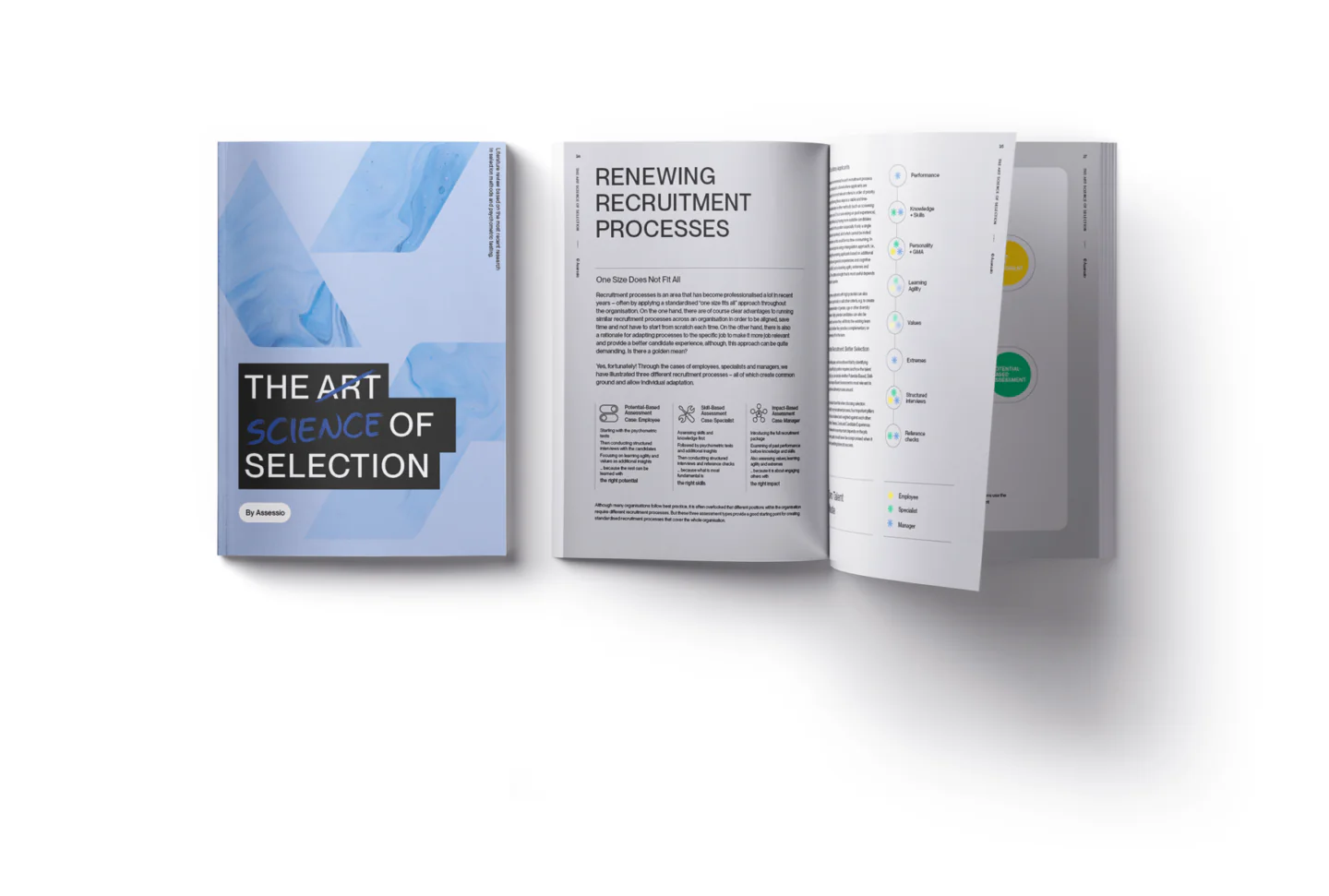Quelle est la meilleure méthode de sélection au monde ?
Spoiler : Il n'y en a pas. Mais il existe une formule.

Tout le monde veut savoir : Quelle est la meilleure façon de choisir la bonne personne pour le poste ?
S'agit-il d'un test d'intelligence ? Des entretiens structurés ? Une intuition enveloppée dans un CV soigné ?
La vérité ? Il n'existe pas de méthode universelle. Mais il existe un moyen de comparer et de combiner les méthodes afin d'obtenir la meilleure combinaison possible pour votre situation d'embauche spécifique.
Quatre éléments qui comptent
Chez Assessio, notre approche pour construire des processus de sélection efficaces est basée sur quatre critères clés :
- Prédiction - Dans quelle mesure la méthode permet-elle de prédire les performances professionnelles ?
- Équité - La méthode est-elle biaisée ? Excluez-vous involontairement des candidats qualifiés ?
- Coût - Le temps et l'argent investis en valent-ils la peine, surtout à grande échelle ?
- Expérience du candidat - Comment le processus est-il perçu par l'autre partie ?
Dans cet article, nous nous concentrons sur ce dernier point, parce qu'il est souvent sous-estimé et qu'il peut faire de votre processus d'embauche un succès ou un échec.
L'expérience des candidats est souvent considérée comme un avantage. Ce n'est pas le cas. C'est un facteur de performance.
Pourquoi l'expérience du candidat est-elle importante ?
L'expérience du candidat est souvent considérée comme une "bonne chose". Ce n'est pas le cas. C'est un facteur de performance.
Elle a un impact direct sur le fait que les candidats postulent, acceptent les offres, recommandent votre entreprise ou renouvellent leur candidature à l'avenir. Les candidats abandonnent chaque jour - non pas parce qu'ils ne sont pas qualifiés, mais parce que le processus leur semble confus, impersonnel ou non pertinent.
Les réactions des candidats
La recherche montre que l'équité n'est pas seulement une question d'égalité de traitement. Il s'agit d'une justice perçue. Les candidats évaluent si le résultat leur a semblé juste, si le processus était logique, comment ils ont été traités et s'ils ont reçu suffisamment d'explications.
L'un des principaux facteurs d'une expérience positive est la pertinence perçue de l'emploi.
Les échantillons de travail et les entretiens structurés obtiennent généralement de bons résultats. Les tests de personnalité ou les tests cognitifs, en revanche, peuvent sembler aléatoires, à moins que vous n'expliquiez en quoi ils sont liés au poste.
Même une courte phrase comme "Cela nous aide à comprendre comment vous abordez les défis liés à l'emploi" peut changer la façon dont le processus est perçu.
Votre processus est un signal
Les gens ne jugent pas seulement le processus. Ils jugent ce qu'il dit de vous.
Vos méthodes de sélection envoient un message sur vos valeurs et votre façon de travailler. Êtes-vous une entreprise qui privilégie l'ambition et la progression de carrière ? Ou une entreprise qui met l'accent sur la responsabilité sociale et la cohésion d'équipe ?
Il n'y a pas de bonne ou de mauvaise réponse, mais il y a un risque à envoyer un mauvais signal. Le contexte est important. Lorsque votre processus de sélection reflète vos valeurs, les candidats le remarquent et y répondent.
Et n'oubliez pas qu'une mauvaise expérience candidat ne fait pas que vous coûter des talents ou nuire à votre image de marque.
Dans les entreprises de grande distribution, les candidats sont souvent aussi des clients - et il n'est pas rare que les gens cessent d'acheter auprès d'une marque après une expérience d'embauche négative, surtout s'ils n'ont pas obtenu le poste.
Vous souhaitez concevoir le bon mélange pour votre prochaine embauche ?
Curieux de savoir comment équilibrer les trois autres critères clés - prédiction, équité et coût - et combiner des méthodes qui fonctionnent réellement dans votre situation ?
Inscrivez-vous pour recevoir notre prochain livre blanc, La science des méthodes de sélection.
Il sera publié le 26 mai et regorge d'informations sur la manière de mettre en place un processus de sélection adapté à votre contexte spécifique et d'éviter les erreurs les plus courantes dans le domaine du recrutement moderne.



